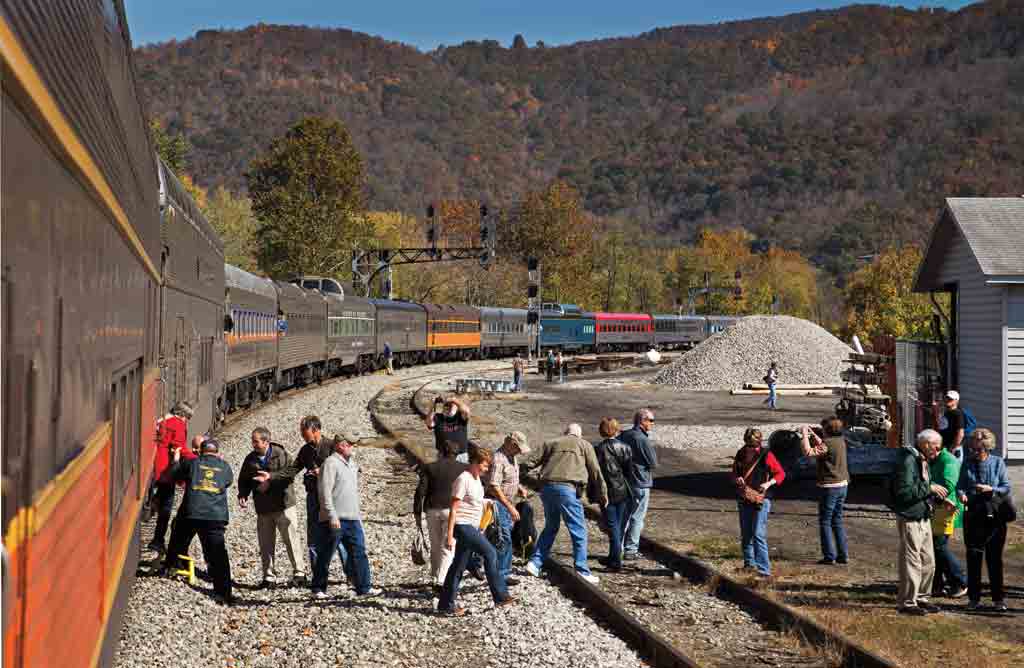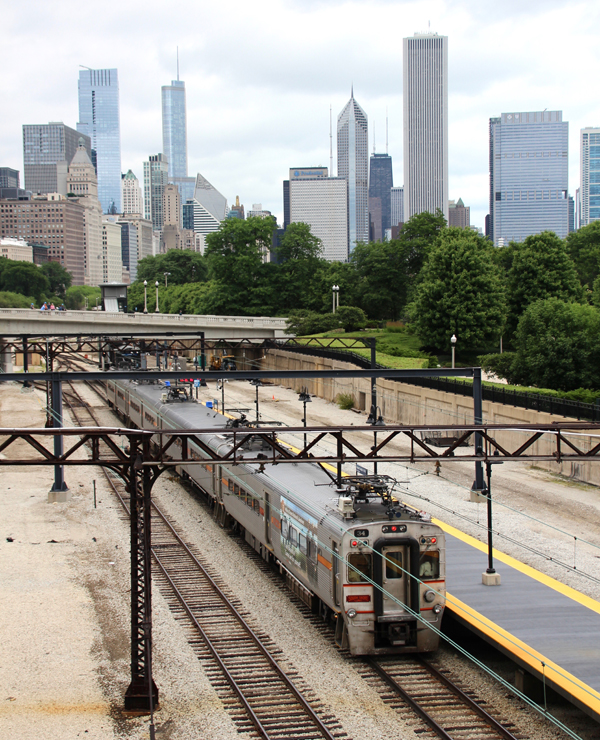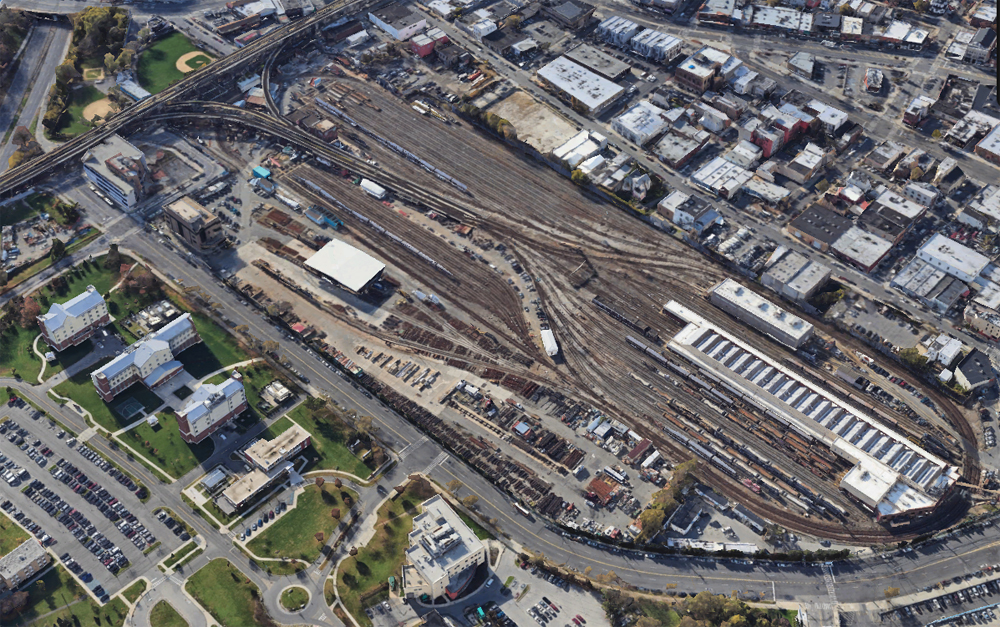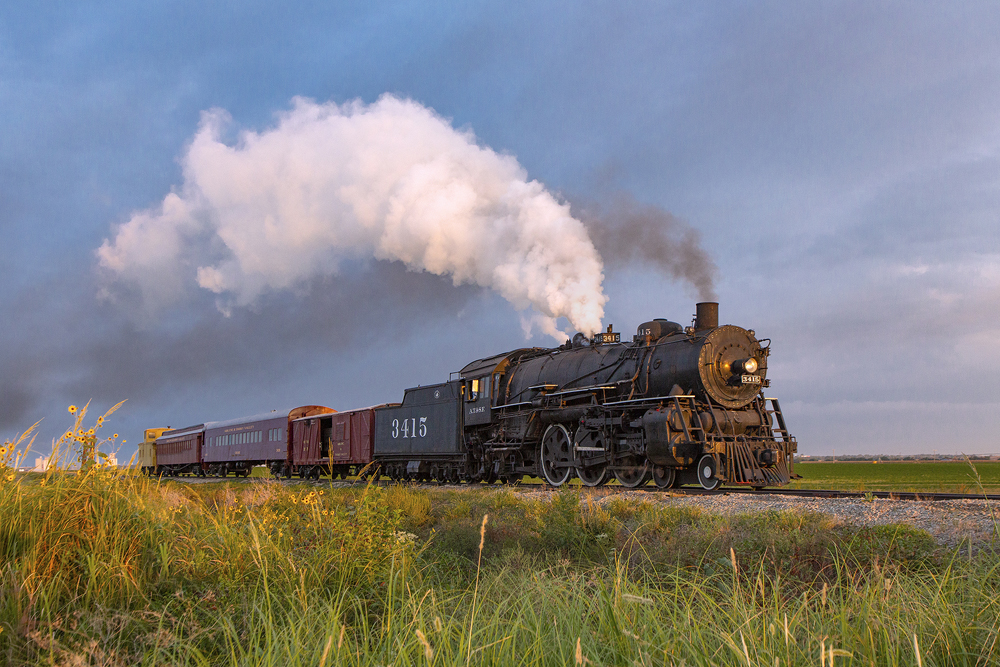On Friday, the passenger railroad confirmed that new mileage rates will require private car operators to pay $3.67 per mile per car, with additional cars costing $2.81 per mile. The rates are the second increase for private cars initiated by Amtrak this year.
New River Train officials say their budgets are already stretched, citing Amtrak’s mileage rates and elimination of Huntington, W.Va., as a switching point, the excursion train’s originating location for its trip to Hinton, W.Va. Eliminating Huntington as a switching point required the non-profit New River Train to pay for a costly equipment deadhead move between Chicago and Huntington and return. The train runs 30 cars long.
After Amtrak announced it was exiting the charter and excursion business in early 2018, the October New River Train was the only Amtrak excursion train to operate in 2018 and it only came about after U.S. Sen. Joe Manchin, D-W.Va., stepped in. He says the train con-tributes about $5 million annually to the West Virginia economy.
Additionally, the excursion train operator is concerned about Amtrak changing terms and rates at its discretion, making it difficult to plan excursions when the railroad has the ability to change those conditions with only 60-days notice.
“Amtrak has traditionally adjusted its private car rates annually on Oct. 1, but now, the rail-road seems to be changing those rates randomly without explaining its reasoning,” New River Train Assistant Executive Director Joe Rosenthal says.
News Wire examined the verbiage associated with various addendums to the passenger car tariff. In Addendum No. 5 taking effect Oct. 1, 2017, which included mileage rate increases, Amtrak said its rates were being adjusted based on the “AAR quarterly index of charge-out prices and wage rates,” saying the rate adjustment will be effective on Oct. 1 of each year.
But less than one calendar year after making that announcement, Amtrak issued two additional rate changes, one taking place May 1, 2018 and another proposed for Jan. 1, 2019. In Addendum No. 6, which took effect May 1, Amtrak omitted verbiage that references the AAR’s quarterly index prices and wage rates – replacing it with the following statement: “Amtrak reserves the right to change the terms and rates contained herein at any time. Private car moves confirmed prior to any such changes will be honored at the rates contained in the confirmation.”
For the New River Train, these unexpected price increases and the inability to pinpoint future costs is likely to put the excursion train out of business.
“We feel like we aren’t customers any longer,” Rosenthal says. “Price increases and limiting how and where we can make our moves with just 60-days is disappointing considering we’re customers who contribute to Amtrak’s bottom line.”
Rosenthal wants Amtrak to explain rate increases to allow the private car industry and rail-road to allow the two groups to work together and to identify areas of cost savings.
“Not only are we Amtrak customers, but we’re supporters and we’ve always had a good working relationship with Amtrak that allows us to tweak our business and work together with the railroad,” he says.
“I don’t think any other business with a monopoly like Amtrak would have the capabilities to increase its rates as drastically as what we’ve experienced with Amtrak in less than 12 months,” Rosenthal adds.
News Wire reached out to Amtrak to ask the passenger railroad how it calculates its car rates, what scales or models are used, and to explain why private car rates have increased twice in a 12-month period.
“The guidelines for private cars on Amtrak indicate that Amtrak’s primary objective is to operate its core scheduled train service safely, punctually, and efficiently. We participate in non-core services such as private cars if they provide a positive financial contribution to the bottom line, provide strategic value, and don’t distract from or impede our core activities,” Amtrak spokeswoman Kimberly Woods tells News Wire.
“The recent price increases and adjustments to terms and conditions support these require-ments and incorporate suggestions and improvements proposed by the leadership of the major private car advocacy organizations,” Woods adds.
News Wire reached out to the Railroad Passenger Car Alliance for comment on involvement with Amtrak and private car policies, to which RPCA President Roger W. Fuehring declined comment and directed Trains to the organization’s most recent newsletter. In the newsletter, Fuehring confirms Amtrak did recently invite him to visit Philadelphia to discuss policies regarding the movement of private cars, car inspector requirements, and insurance requirements, as well as safety, rates, and fees.
Fuehring says the conversations were well received and there were several suggestions, revisions, and verbiage that was removed, added, or better defined.
“It’s crucial to understand that several employees of Amtrak have worked very hard to develop a policy within the parameters set forth by the management of Amtrak. The goals set forth included efficiencies within the network, cost, risk management, labor and availability of equipment,” Fuehring’s letter.
“It may not be the desired outcome, and some owners will follow others in shutting down their operations based on cost,” Fuehring says. “For others, they will take the time to evaluate the new parameters and develop their operations accordingly.”
Trains has also asked the American Association of Private Railroad Car Operators for comment.
Rosenthal says these price increases and new adjustments will require the organization to increase its ticket prices, which he believes would price them out of the market and result in less ridership. Coach tickets are currently $179 per person; premium seats are $279; and business class is $600 per person. Currently, about 4,800 passengers ride the New River Train during its four day-long excursion dates each October.
New River Train, an arm of the C.P. Huntington Chapter of the National Railway Historical Society, declined to share costs or its agreement with Amtrak, but the group did confirm that despite these challenges, it is still making its request to operate in 2019.















Amtrak ought to change its name to Anthrax.
As Mr. McGuire has never put inn 40 yrs at Amtrak like I have, He is as usual clueless to the fact that DELTA DICK is going along with the GOP to make Amtrak so useless that it can be killed off. Boxed cold meals and less then minimum maintence is the new way of life on the RR. Mr. Gunn was the best we ever had but because he didn’t play politics with the GOP, he was forced out. Her told the truth and they hated him for it !
I thank congress should ask if he has stock in airline, or has interest in the airline co. he is doing his best to kill the passenger service, there a lot ways amtrak can make money,
Mr. McGuire: Indeed, you’re absolutely right!
In 2018 there’s no such thing as a free lunch anymore. I can only take a wild guess what libility insurance rates cost in Century Twenty-One. A good number of museum and tourist operations face the same problem and why several have been forced to discontinue services. All it takes is some irresponsible train nut to stub a toe while carelessly crossing the track and WHAM-O Batman, see how quick the operator is hit in the caboose with a hefty law suit!
If raising rates and imposing some restrictions on private cars makes the service profitable and contributes to Amtrak’s bottom line I say go for it. The complainers are just those liberals who want someone else to pay for their fun. if hauling private cars is not a profitable business for Amtrak they should get out of it. Plain and simple. Amtrak is in the business of running (loosely) scheduled passenger trains. Any sideline operations need to be profitable or discontinued. Where was the hue and cry when the ill-fated package express business was discontinued? Nobody really cared because they weren’t getting something that was paid for by someone else. Other than Mr. Gunn, Mr. Anderson is the first Amtrak president who “gets it”.
A few questions: 1. Does VIA handle private charters? 2. Do private charters provide a marketing advantage to potential customers? 3. If Amtrak is a public corporation, recipient of public funding, how does Amtrak have responsibility to all taxpayers’ concerns?
Mr. Toth – I was, for many years and hundreds of thousands of miles. Carried hundreds of folks who weren’t spring chickens, but managed to navigate the rail environment safely. I have posted this thought recently, but I will say again, thank God and Graham Claytor I’m out of this game, having had my fifteen minutes of fame, but I empathize with my former colleagues who have carried on in this increasingly hostile environment. I do believe that this, too, shall pass. Ex-PRR 120 is now owned by Bennett Levin of Philadelphia, who is taking good care of it. We don’t really own these treasures – we are stewards preserving history for future generations. Thanks for the compliment, but I am happily retired on a farm in upstate new York, grumbling daily on the Trains Newswire, in addition to other rail-related activities.
How about burning a tattoo on Anderson’s forehead: I Hate Trains! …LOL
Mr. Pins: Are you the proud owner of Pennsy 120? You wouldn’t be interested in the job of running Amtrak by any chance? If dreams could come true…
Mr. Pins: I will only say WOW to your fifteen minutes of fame. I carried on an “envelope friendship” with Mr. Claytor while he was running Amtrak. I was employed with Deutsche Bundesbahn in Nuremberg at the time. At my request, he sent me a glossy b&w photograph personally signed, which I treasure. I also retained the letters he wrote back to me. Regrets that I was unable to visit him in DC at the time.
I can understand all the excitement going on to get as many steam locomotives as possible up and running after having sat cold for so many years but if I had my druthers and $$$ I’d be picking up as many GG1s as I could get my grubby hands on instead. Though a Texan by birth and still quite fond of Miss Katy, including the Deramus era no less, I do happen to have a Keystone in my heart for the Pennsy.
Enjoy yourself on the farm. I was raised on my grandparent’s small farm north of Dallas in Farmers Branch, now called “The Branch” by the high class social crowd, so I do envy you for your laid back way of life.
Have you considered (or have you) written an artical and submitted to Classic Trains about you and PRR 120?
Railroading yours,
Joe
About me: http://www.railroadevangelist.com All Aboard magazine, Summer 2015 issue; page eight and nine.
Jim for someone who is so uptight about graffiti I am surprised you would advocate a pie (graffiti) on Mr. Anderson’s face.
Take a look at the photo accompanying this story. My safety manager’s “risk and hazard radar” went off. Do you see passengers (some who are not Spring Chickens) alighting onto a sloping step box? Walking on uneven ballast? Not wearing supportive footwear? One gentleman appears to be having trouble stepping over a rail, or might be assisting another person (obscured) to step over the rail. And another is walking in front of the ballast pile, heading away from the train in likely search of a photo spot. Can you imagine a similar scene happening occurring at ATL’s Ramp 2? Or on taxiway B? Or at the N2 ILS hold point?
Mr. MacFarlane, when I worked at U.S. Railway Association back near the end of the Jurassic Period, I had to read all of the Amtrak legislation AND scan most of the House and Senate hearing testimony. If memory serves me correctly, there was never any discussion of private car and charter train movements. Someone with a more recent review may correct me, but I think the Congressional record is silent on Amtrak’s private car and charter train obligations. Keep in mind that it’s a near certainty that somebody in Amtrak’s public affairs/PR office is tasked with reading industry news stories AND comments. Snarky-to-profane comments are not helpful in the ongoing efforts of others to preserve or improve PV owner access to Amtrak operations. I’d cool it. Even though Amtrak has annulled one of my major film production resources, I am placing my bets on Anderson to create a strategically viable system capable of supporting growth. It certainly won’t look like today’s Amtrak, but take note — Delta doesn’t fly Boeing 727’s or DC9-30s anymore. And nobody expects DL to run 40-year-old antiques.
Arthur J Miller,
The “pie” comment is not a bit harsh…I would be harsher and say the Mr. Anderson doesn’t know what the “F***” he’s doing running a railroad, since he’s familiar with running an airline…100% diametrically opposed businesses. Matter of fact, I’d bet I could do a better job for 50% less salary than Mr. Anderson, mostly by using COMMON sense and being a pit bull with Congress(and getting Congress to sack the BoD and eliminate it entirely). Yes, I do believe Amtrak can easily handle PV and charter trains, without losing money or affecting the base operations. Also, you have to sit down with the railroads and remind them of why they no longer run passenger trains and exactly what they agreed to way back when, the current group seems to have forgotten.
Mr. Norton: There are two sides of the debate on whether Amtrak has legal and/or moral obligations to continue running a unique novelty service appealing to, and used by, a relatively few…or if a vastly larger majority of travelers should be Amtrak’s sole strategic business focus. While filming a commercial out of LAUPT a few years ago, I got a large dose of ill-will when our production equipment load-in to a chartered coach delayed the Surfliner’s departure. I was “reminded” that Flight Attendants needed to get to airports; shift workers had time clocks to punch; and nurses needed to be at hospitals. Richard Anderson, who ran a dang fine airline, is facing a real dilemma. The “pie” comment is a bit harsh, don’t you think?
Its time for a pie in the face to Mr. Anderson.
Just checked the spelling for the former British PM. It’s Chamberlain. Sorry.
Mr. Fuehring sounds more like a Chamberlin kind of guy than a Churchill. If I was having this nonsensical crap thrown in my face, I wouldn’t be “evaluating new parameters” (look what what happened to Chamberlin); the only light I see here is through legislation directing Amtrak to run these trains and operate these cars with reasonable rates and with reasonable regulation, neither of which obtains now. If that is politically impossible at this time, then it’s Goodbye Charlie for now, live to fight another day in a different climate.
And the battle continues. Could it be that private car charters will soon be limited to cooperative regional railroads and short lines, and to a few large tourist/historic/scenic railroads? Hollywood has already realized that, unless Amtrak has a spare car available for a scheduled train on a current route, Amtrak is no longer an option for entertainment production charters. And it’s a great loss in the constant battle for unique images and on-screen production values.